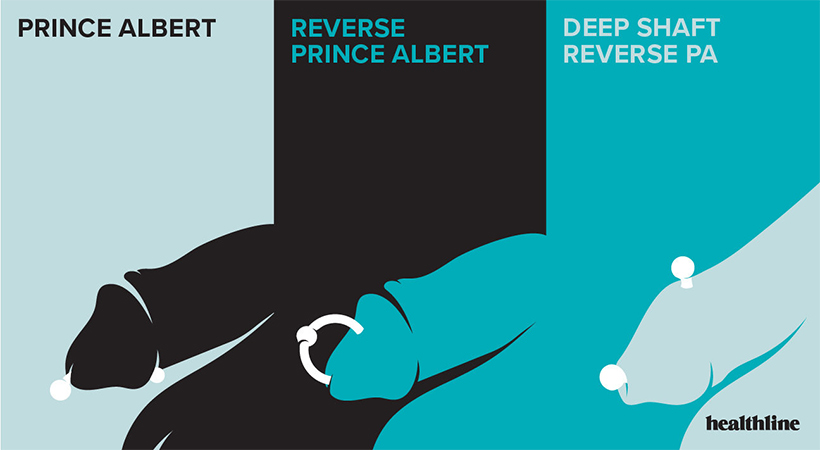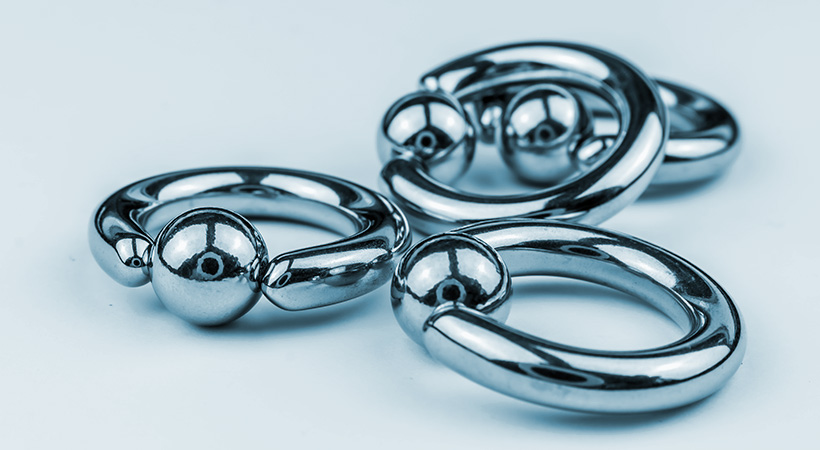It’s the actual prince of piercings.
The Prince Albert piercing (PA) is one of the most popular genital piercings for men. A long-time favourite in the fetish community, it’s a fascinating combination of edgy, horny and experimental. With a whole range of bars, rings and even bespoke jewellery to choose from, it’s also a bit #fashion.
But does it hurt? Can you fuck with it? Does it show up at airport security? Would getting one mean you’re a pig? Like a lot of guys, we have questions, so we got together with three proud PA penis piercing owners (say that three times quickly) to get some answers. The gents graciously let us into their lives and their pants, for a little PA Q&A.
Names have been changed for privacy.
What is the Prince Albert piercing?
A Prince Albert is a piercing that goes down through the urethra (the hole in the end of your penis) and out through the underside of your penis, below the head (usually just near the little piece of webbing at the front, called the frenulum). You can also get a reverse PA, which comes out through the back of the head itself, or a ‘deep shaft’ reverse PA, which comes out further down the penis, below the ridge of the head.
The name comes from the legend/rumour that Prince Albert (Queen Victoria’s husband) had one, possibly to anchor his penis inside tight trousers. There is almost zero evidence to support this, but it’s a fun story.
 Image credit: healthline.com (Illustration by Brittany England)
Image credit: healthline.com (Illustration by Brittany England)
What was it like getting the Prince Albert piercing? Is it safe? Does it hurt?
David: The actual process of getting it done was very clinical. The technician talked me through it. It was all approached from an aesthetic point of view, like where I wanted it to sit and how I wanted it to look. I went to a very well-regarded professional piercing place, so the safety side of it was all very clear.
Mike: The process was very quick. It’s essentially a needle in a tube – they put it through the pee-hole and then whack it in. It was just like a sharp scratch and that was it. Make sure you go to someone who specialises in this sort of piercing, though. They can give you the right advice to get it in the right place, and they tell you how to take care of it while it’s healing.
“It was just like a sharp scratch and that was it.”
James: It didn’t really hurt. I felt a momentary prick. There was no bleeding. There was a little bit of soreness the next day. You definitely need to go to someone who is a member of the Association of Professional Piercers or Australasian United Professional Piercers — they’ll give you proper aftercare and they won’t let you put in something that’s the wrong size or in a tricky placement.
How was the healing process?
Mike: The worst part was four hours after the piercing, when the blood had dried and I was trying to peel off the dried-on packing. But otherwise, it was fine. I dunked it in a cup of salt water morning and night and it healed quickly. Also – if you don’t drink enough water and your wee is a bit acidic, it will burn! They say it takes 3-6 months for full healing, but I think mine was a bit quicker than that.
David: The healing process is the painful part. It’s quite clinical and not very exciting. I got mine done about six months ago and I wouldn’t say it’s completely healed yet. It can get a bit sore and tender if guys don’t know how to play with it.
James: They told me to refrain from sex for about six weeks. I think I used the same antibacterial stuff they use for tattoos. Also, when you first get it done, the gauge is very small, so you have to be careful of the ‘cheese cutter’ effect – it’s essentially a thin wire, so strong dragging or pulling can cause it to cut you.
What’s having a Prince Albert piercing like day to day?
James: Maintenance is as easy as regular showering. Mine actually feels a little bit like a mild sounding a lot of the time – that sort of pleasurable ‘itch’ in your urethra. You usually have to pee sitting down, though, especially if you’ve got a bigger gauge. You now have two holes in your urethra, and when you pee it goes everywhere, which is not a good look at a urinal.
Mike: Going to the bathroom, you’ve got to hold the ring in a particular spot so it doesn’t spray everywhere. Otherwise, I’ve had it so long I guess I’m used to it now. It doesn’t set off the alarms at airport security or anything, but I think it shows up on the full body scans they do in US – I’ve been asked by the guards if I’m wearing a belt!
David: I love the weight of it. I have to be a bit careful that it doesn’t catch on anything while it’s healing, but otherwise I love it. I’ve always been fascinated by PAs since I first saw them in porn, so I love the look of mine.

Does a Prince Albert piercing increase pleasure during sex?
David: For oral sex, I let guys know they need to be gentle and tender with it, and it can definitely hurt when you’re having sex, either as the top or the bottom. I don’t really want to take it out at the moment, because mine is still quite new. At the same time, it’s definitely increased my pleasure and sensitivity, the same way guys say that getting their nipples pierced suddenly makes them ‘hardwired’ for pleasure. It’s easier for me to cum, and the orgasms are more intense.
James: It’s a big turn on, but I don’t think it makes a big difference to me physically when I top. You notice it much more if you’re bottoming. The prostate stimulation is very noticeable, especially with a captive bead ring. If I’m topping and guys want me to keep the jewellery in, I try to stay all the way inside once I’ve gone in the first time – there’s no pulling all the way back out and then back in, if that makes sense. It’s just to minimise the chance of it catching on the sphincter or hurting him.
“… it’s definitely increased my pleasure and sensitivity …”
Mike: A lot of it is about the way it looks, but it’s quite fun to play with the movement of the ring. I’ve got a segment ring, which doesn’t have any joins and you need a pair of pliers to open it, so it’s not really an option for me just to take it out. It sounds a bit strange to say it, but it kind of ‘weeds out’ sexual partners who aren’t a good match. If someone looks at it and wants to play with it, then it’s a ‘yes’; otherwise, it’s definitely a ‘no’.
What’s one thing you would tell someone before they get a Prince Albert piercing?
Mike: Make sure you really want it. Once you’ve got a hole this size in your dick, you’ve got it forever. If you decide after it’s healed that you don’t want it, it won’t necessarily close over. That means everything will shoot out sideways from the hole below the head, forever.
James: For safety, I would always go for a condom with lube when you’re having sex. Even though the piercing wound is healed, you have an extra hole into your urethra, which means there’s all that extra surface area for UTIs and STIs to get into.
David: One thing I would like to have known is tips and tricks on helping with the healing process. Just more little things you can do to help with the pain and the healing. I wish I’d looked at that more ahead of time.
Editor’s note: Irritated or broken skin on your or someone else’s penis can increase the risk of HIV and other blood borne viruses during sex. Like James recommends, using a condom prevents HIV and reduces the risk of STIs. Whether you do or don’t use condoms, choosing PrEP or relying on an undetectable viral load are effective ways to prevent HIV.
What should I do first if I’m thinking of getting a Prince Albert piercing?
Do some research on potential piercers. Make sure they’re experienced and have a track record of safe, quality work.
The first thing you should check out is their health and safety training. The body piercing industry isn’t regulated on a national level, but states and territories have their own regulations and codes of practice around skin penetration. If you’re thinking about getting any sort of piercing, make sure your piercer operates in line with these codes, which require training in hygiene, safety, aftercare and infection prevention. They should be able to show you that they’ve completed this training, and answer any questions you have about it.
If you’re living with HIV or any other health conditions (like hepatitis B or hepatitis C), make sure you check the law in your state or territory about whether you’re legally required to disclose your status for skin penetration services.
The HIV/AIDS legal centre (HALC) has guides to HIV and the law for New South Wales, Queensland, South Australia and Western Australia. If you live elsewhere in Australia or have any other questions about HIV and the law, you can contact HALC directly for help.
Note that it’s illegal anywhere in Australia to refuse to provide anyone a service because they are HIV-positive under the national Disability Discrimination Act (1992).